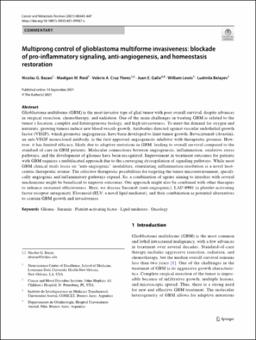| dc.description.abstract | Abstract
Glioblastoma multiforme (GBM) is the most invasive type of glial tumor with poor overall survival, despite advances in surgical resection, chemotherapy, and radiation. One of the main challenges in treating GBM is related to the tumor's location, complex and heterogeneous biology, and high invasiveness. To meet the demand for oxygen and nutrients, growing tumors induce new blood vessels growth. Antibodies directed against vascular endothelial growth factor (VEGF), which promotes angiogenesis, have been developed to limit tumor growth. Bevacizumab (Avastin), an anti-VEGF monoclonal antibody, is the first approved angiogenesis inhibitor with therapeutic promise. However, it has limited efficacy, likely due to adaptive mutations in GBM, leading to overall survival compared to the standard of care in GBM patients. Molecular connections between angiogenesis, inflammation, oxidative stress pathways, and the development of gliomas have been recognized. Improvement in treatment outcomes for patients with GBM requires a multifaceted approach due to the converging dysregulation of signaling pathways. While most GBM clinical trials focus on "anti-angiogenic" modalities, stimulating inflammation resolution is a novel host-centric therapeutic avenue. The selective therapeutic possibilities for targeting the tumor microenvironment, specifically angiogenic and inflammatory pathways expand. So, a combination of agents aiming to interfere with several mechanisms might be beneficial to improve outcomes. Our approach might also be combined with other therapies to enhance sustained effectiveness. Here, we discuss Suramab (anti-angiogenic), LAU-0901 (a platelet-activating factor receptor antagonist), Elovanoid (ELV; a novel lipid mediator), and their combination as potential alternatives to contain GBM growth and invasiveness.
Keywords: Glioma; Lipid mediators; Oncology; Platelet-activating factor; Suramin.
© 2021. The Author(s). | es |


